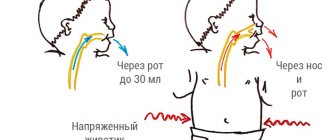When babies roll over onto their stomachs
A newly born baby faces a tremendous amount of work. For his parents, controlling their body is a familiar and understandable matter; they don’t even think about this process. It is very difficult for a baby to even just raise his head, not to mention roll over, sit down, stand up, and walk. His muscles are not yet ready for such loads; everything is being mastered gradually.
In order for the baby to raise his head, his neck needs to be strengthened. To roll onto your side, stomach, or back, the corresponding muscles must be sufficiently developed.
Are revolutions realistic in 2 months?
Many parents (especially firstborns) tend to compare their neighbor’s child and their own. If the first one turned over at two months, the same will be expected from the second one. Those who compare will most likely be upset. Because at two months the baby may not yet be able to roll over from his back to his stomach or even to his side, this is normal. The standards for mastering the skill are as follows:
- At three months - attempts to roll over on its side.
- At four months - roll over onto stomach.
- At five months - from the stomach or side to the back.
Baby learns to roll over on its side
Important! All the above rates are averages. The baby can either get ahead of them or lag behind them. If he is completely healthy (according to the pediatrician, neurologist and orthopedist), then he has every right not to master some skills at all. In particular, not all children learn to roll over onto their back. From the tummy position, they can rise to all fours and immediately sit down.
Why are there no revolutions at 3-3.5 months?
Usually at 3 months the baby does not yet roll over onto his stomach, but only tries to roll over onto his side. How long before he finally learns to do this depends on a number of factors:
- Temperament of a little person. A melancholic baby is less inquisitive and active than a choleric baby, so he will begin to move actively later.
- Child's weight. The heavier the baby, the more difficult it is for him to master his body.
- Parental attention. If adults work with the baby, do massage and gymnastics with him every day, then his physical fitness will be better than that of a baby without training.
- Strength of health. Children who get sick more often spend their energy primarily on recovery, and only then on mastering skills. Therefore, in general, in terms of movement skills, they lag behind peers with good health. Children born prematurely develop with a slight lag.
The baby turned over on his stomach
At what age do babies learn to roll over?
In fact, the very question of why a 3-month-old baby does not roll over is not entirely correct. All parents should know when their newborn begins to roll over. Indeed, the ability of a baby to roll over onto his back from his tummy and back is one of the main indicators of his normal physical development. And the fact when he begins to do this is determined by a number of factors, including the development of the nervous and muscular systems, the possible presence of chronic diseases, as well as the characteristics of the musculoskeletal and nervous systems of an individual baby.
Of course, some make their first successful attempts at revolutions after reaching the age of two months. However, children should normally master this skill between 3 and 6 months of age. Therefore, the question of why a child at 3 months does not roll over disappears by itself.
Do not forget that mastering such a complex movement on your own is not easy. At a minimum, the baby needs to be helped to understand the principle of the revolution itself. In addition, the task of parents is also to reveal to their child all the delights of such a maneuver. So, how can you help your child learn to roll over? Here it is enough to know a few simple rules.
One way or another, if the pediatrician does not see any deviations in the development of an individual baby, then there is no reason to worry. At this stage, parents can only help him master a new skill.
How to teach to roll over
List of things for a newborn
In the third or fourth month of life, the baby should begin to learn to roll over on its own. Parents have the power to help their child so that learning goes faster and more successfully.
Massage and gymnastics
For an adult, the best way to strengthen his muscles is through strength sports. They are not yet available to the baby. Their role for now is performed by massage. He can be professional and superficial. The first should be carried out only by a specially trained children's massage therapist, the second - by parents.
Massaging should include rubbing the limbs, pinching (including the tummy), and patting. It is imperative to control the strength of your hands: the movements should be effective enough for the baby, but not painful. Excessively strong pressure can injure the baby.
Pinching the abdomen and sides will be especially useful in mastering coups. This simple exercise improves blood circulation in the desired area, warms up the muscles and encourages the baby to tense them. Finally, it improves the baby’s mood if done correctly (without discomfort).
Massage usually precedes gymnastics. During it, the child’s body is not only exposed to external influences, it is also stimulated to move more. For example, the following exercises are very useful:
- Pull-ups. The baby is placed on his back. The adult places his thumbs in his palms, the baby must grab them. The parent insures the child's palm with his own. You need to slightly lift the baby by the arms, holding them at the level of his face. Not in a sitting position - this will harm the spine. So that the children's shoulders come off the surface. The purpose of the exercise is to force the baby to tense his tummy and arms, to stimulate attempts to pull himself up.
Baby pulls himself up
- Revolutions. After the warming massage, you need to take the baby by the right thigh and turn him to the left. The left leg is simultaneously held in place. The baby will begin to roll over and his shoulders will follow his pelvis too. So the adult will show the baby exactly what he needs to do.
Swimming
It is better if the little one does infant swimming in the pool. This physical activity makes all the muscles of the body tense, which strengthens them, but also relaxes them, so you can go swimming at night. If a child does not roll over at three months and does not even try, his muscular frame definitely needs such strengthening. Swimming on your stomach will be extremely beneficial.
It is important to note! The use of a circle in this case is not necessary - it supports the neck itself, provoking muscle relaxation rather than tension. It is better for healthy swimming to hold the baby in the water in your arms. This will force the baby to try to control the position of his body.
Laying on the stomach
The sooner and more often you put the baby on his stomach, the sooner he will try to roll over on his own. This simple action will strengthen the muscles of the tummy and neck, and awaken interest in the world around you. It is recommended to lay it out on a hard and flat surface - on the floor, for example. You can practice exercises on a fitball: springs, rolling the ball when the baby lies on it on his stomach.
Baby on fitball
Note! It is important not to overdo it with training. If you are too active with your child, he may begin to be afraid to do what is expected of him.
Exercise “Turning from back to stomach and back” on a fitball
Rolling from back to stomach is a very important physical skill in a baby’s development. Usually it is trained and mastered at the age of 3-4 months, turning from the stomach to the back - by 6 months.
Let's look at how you can teach this skill using a fitball.
- The baby lies on his side on a fitball. An adult holds his stomach and back with his palms on both sides.
- We start with the usual rocking back and forth in this position on the side.
- Next, we push the baby’s thigh with our palm, stimulating him to roll over on his own, and if this does not happen, we roll him onto his stomach. At the same time, we do not let go of the child.
- Then simply roll back onto your back. The actual flip action can be accompanied by lightly rocking the ball back and forth.
Attention! When performing exercises on a fitball, be careful! Start small, roll on one side and the other, get used to it, feel how the baby behaves on the ball.
You do not need to have any special physical abilities to perform this exercise. We do not hold the baby in outstretched arms - the adult's hands lie on the ball. We simply roll the child over the surface of the fitball.
When to start worrying
What to do if the baby's temperature is 38 degrees
If a child does not want to roll over onto his stomach by 5-6 months, this is a reason to visit a pediatrician. He will refer you for additional examination to a neurologist and orthopedist. Perhaps the baby will develop hypo- or hypertonicity or more serious pathologies. By the age of 3-3.5 months, the baby may not be able to tumble, this is normal if the child is completely healthy.
Parents must remember: you cannot blindly follow the average norm, since the individuality of the toddler plays a large role in the development schedule. You need to devote your time and attention to the child, and also visit the doctor as needed and as planned. This minimizes the risk of developmental delays.
Causes
In premature newborns, development lags behind that of children of the same age. Also, a lag can be observed in babies whose mothers had problems with pregnancy, such as:
- fetal hypoxia;
- long-term, severe toxicosis;
- infections and gynecological diseases;
- smoking, drinking alcohol;
- multiple pregnancy;
- asphyxia during childbirth, etc.
Congenital pathology of the fetus will also cause movement disorders: pneumonia, heart disease and pulmonary disease. During childbirth, the neck, collarbone or hip joint may be injured, so you should not ignore the obvious signals that appear in the fact that it hurts the baby to lie on his stomach, he drops his head and cries.
Timely treatment in the form of electrophoresis of the cervical spine, specialized massages and injections will eliminate the defect in time.
If you are concerned about delayed motor development, discuss this issue with your pediatrician. A delay of four months in turning on one side indicates a problem in the development of diseases such as dysplasia, neurological diseases, and the musculoskeletal system.
Late skills of turning onto one's side are sometimes associated with weakness of the muscular corset. Muscle weakness can be general (hypotonia) or local in nature (decreased tone of any specific muscle groups, for example, the abdominal or back muscles).
It is also worth paying attention to the child’s excessive weight, which makes it more difficult to control his body, because this requires strength.
How to motivate a child to roll over?
Parents can help their baby develop the necessary muscles by doing simple exercises with him. When training your baby, do three-minute intervals so that the baby has time to rest and realize what is happening to him. Do not force the child, do all training movements in the form of a game so that they bring joy to the little one, praise him if it works and ask him to repeat the trick.
There are several simple ways:
- Before starting rollovers with your child, you need to make sure that the baby is lying comfortably on his stomach with his head raised, skillfully leaning on his arms.
- You can help your baby roll over by placing him on his stomach and placing his favorite toy out of reach so that he can reach it; the baby will flounder from side to side until he turns over. Watch which side he likes to roll over; most children prefer one side more than the other.
How do children make a coup?
It is easier for a child to roll over if he lies on his stomach, leaning on his arms, easily rolls over onto his side, and then onto his back. The round shape of the baby's belly allows him to sway merrily from side to side and then roll over. Children are delighted with these activities and often want to repeat them over and over again, while some children will be able to repeat such a feat after a few weeks. But what to do if the child does not perform the above-mentioned movements at four months?











